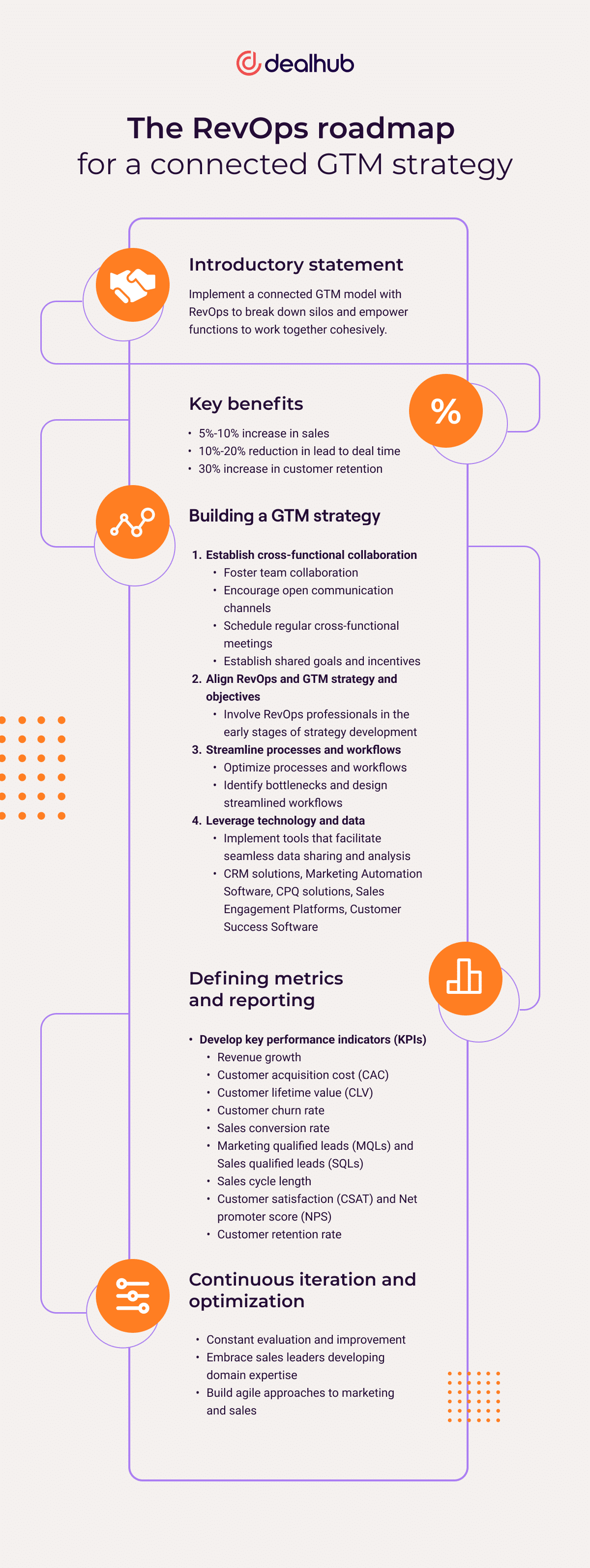How a GTM can go off-course
Disconnected sales, marketing, and customer success functions can quickly derail a GTM strategy. Siloed teams often result in poor communication, missed opportunities, and an inconsistent customer experience. Without a centralized approach and coordination, the sales team might be chasing leads that marketing has already disqualified, leading to frustration and wasted effort. Additionally, customer success teams require specific insights from sales and marketing to engage clients effectively. This fragmented approach ultimately hampers revenue growth and harms customer relationships.
The RevOps roadmap for a connected GTM strategy

Organizations must implement a connected GTM model with RevOps to overcome these challenges and steer toward success. By doing so, they can break down silos and create a unified front that empowers all functions to work together cohesively. The proof is in the numbers: according to McKinsey, optimizing a GTM strategy can enable:
- A 5% – 10% increase in sales
- 10% – 20% reduction in lead to deal
- 30% increased customer retention
Not sure where to begin when building your own optimized GTM strategy? Start here! The following is a simple roadmap to drive a connected GTM model with RevOps:
Establish cross-functional collaboration
The first step towards a successful RevOps-connected GTM strategy is fostering team collaboration. RevOps, marketing, customer success, and sales teams must collaborate to facilitate revenue growth. Encourage open communication channels, schedule regular cross-functional meetings, and establish shared goals and incentives. When everyone is on the same page, aligning strategies and delivering a seamless customer experience becomes easier.
Align RevOps and GTM strategy and objectives
RevOps and GTM strategies must align for optimal results. Involve RevOps professionals in the early stages of strategy development to ensure their insights and expertise are integrated into the plan. This alignment ensures operational decisions are grounded in data and contribute directly to revenue growth.
Streamline processes and workflows
RevOps can optimize processes and workflows, reducing inefficiencies and automating repetitive tasks. When teams spend less time on manual work, they can focus more on driving revenue and delivering personalized customer experiences. Identify bottlenecks and inefficiencies and collaboratively design streamlined workflows that benefit all departments.
Leverage technology and data
Technology and data are at the heart of RevOps. Implement tools that facilitate seamless data sharing and analysis between sales, marketing, and customer success teams. A unified tech stack enables a holistic view of the customer journey, empowering teams to make data-driven decisions and anticipate customer needs.
RevOps teams can leverage various tech tools and platforms to facilitate seamless data sharing and analysis across sales, marketing, and customer success functions. These tools enable real-time access to data, improved collaboration, and better decision-making. For example, here are some useful tech tools that RevOps can leverage:
Customer Relationship Management (CRM) solutions: CRM tools are fundamental for RevOps teams. It centralizes customer data, interactions, and sales opportunities. With a CRM, teams can track leads, manage customer accounts, and analyze sales performance.
Marketing Automation Software: Marketing automation tools streamline marketing processes and campaigns. They automate email marketing, lead nurturing, and social media management tasks. Marketing automation platforms like Marketo, Pardot, and Mailchimp provide valuable data insights that can be shared with the entire organization.
CPQ (Configure, Price, Quote) solutions: These platforms can be vital in driving a connected GTM model. CPQ solutions enable organizations to streamline their sales processes by automating the configuration, pricing, and quoting of products and services. With CPQ, companies can:
- improve sales efficiency
- make data-driven decisions
- integrate seamlessly with CRM and ERP systems
- personalize the customer experience
- speed up sales cycles
- optimize revenue
- streamline contract management
Sales Engagement Platforms: These platforms streamline sales processes by combining email tracking, sales automation, and sales analytics. They provide valuable insights into customer interactions and ensure sales teams stay organized.
Customer Success Software: Using this software, customer success teams can track and manage customer health, satisfaction, and renewal data. These tools often integrate with CRM systems to provide a holistic view of customer relationships. Examples include Gainsight, Totango, and ClientSuccess.
Define metrics and reporting
A successful RevOps-connected GTM strategy requires clear and consistent metrics for measuring success. Work together to define key performance indicators (KPIs) and establish regular reporting processes. These metrics provide real-time insights into the effectiveness of your strategy and guide continuous improvement efforts.
Some effective KPIs for developing a GTM strategy with RevOps include:
Revenue Growth: This is the ultimate KPI for any GTM strategy. It measures the overall increase in revenue over a specific period. A revenue growth KPI clearly shows the strategy’s effectiveness in driving sales and generating revenue.
Customer Acquisition Cost (CAC): CAC measures the cost of acquiring a new customer. It includes marketing, sales, and operational expenses. A lower CAC indicates that the GTM strategy efficiently acquires new customers cost-effectively.
Customer Lifetime Value (CLV): CLV measures the total revenue a customer generates throughout their relationship with your business. A high CLV indicates that the GTM strategy attracts valuable, long-term customers.
Customer Churn Rate: Churn rates measure the percentage of customers who drop out of using a product or service over a specific period. A lower churn rate indicates that the GTM strategy effectively retains customers and improves customer success efforts.
Sales Conversion Rate: This KPI measures the percentage of leads that convert into paying customers. A higher conversion rate indicates that the GTM strategy successfully converts leads into sales.
Marketing Qualified Leads (MQLs) and Sales Qualified Leads (SQLs): MQLs and SQLs track the number of leads that marketing and sales teams qualify as potential customers. Effective lead qualification ensures marketing and sales efforts target the right prospects.
Sales Cycle Length: This KPI measures the (average) time it takes to convert leads into customers. A shorter sales cycle indicates that the GTM strategy efficiently moves prospects through the sales pipeline.
Customer Satisfaction (CSAT) and Net Promoter Score (NPS): These KPIs measure customer satisfaction and loyalty. High CSAT and NPS scores indicate that the GTM strategy delivers positive customer experiences.
Customer Retention Rate: This KPI measures the percentage of existing customers retained over a specific period of time. A high retention rate indicates that the GTM strategy keeps customers engaged and satisfied.
By tracking these KPIs, businesses can gain valuable insights into the effectiveness of their GTM strategy and the impact of RevOps initiatives. Optimization based on these metrics will lead to a more aligned, efficient, and customer-centric GTM model with RevOps.
Continuous iteration and optimization
RevOps is a dynamic process that demands constant evaluation and improvement. Encourage continuous learning, embrace sales leaders developing domain expertise, and build agile approaches to marketing and sales. Monitor performance metrics, gather team feedback, and iterate on your strategy to stay agile and responsive to market changes.
Heading in the right direction
As your organization embraces a connected GTM model with RevOps, you’ll notice remarkable alignment, efficiency, and revenue growth improvements. Silos will fall away, and teams will unite to deliver an outstanding customer experience. The collaborative spirit fostered by RevOps will pave the way for future success, allowing your business to thrive in an ever-evolving market.
RevOps is not just a buzzword! This modern operating model empowers businesses to drive better customer experiences and sustainable growth. By integrating and optimizing sales, marketing, and customer success functions through RevOps, organizations can break down barriers, streamline operations, and achieve revenue goals. Embrace the power of RevOps today to take your revenue to the next level.




